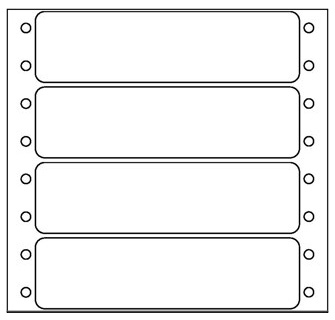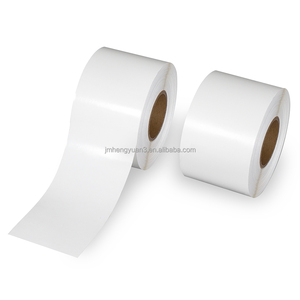Recyclable Blank Labels for green packaging.
Comprehending Just How Blank Labels Work to Boost Your Labeling Experience
Comprehending the auto mechanics of blank labels is essential for optimizing your labeling methods across different contexts. To totally realize just how these labels can change your processes, one should think about the various kinds available and the myriad methods they can be personalized to suit certain demands.

Advantages of Making Use Of Blank Labels
Blank labels use a versatile remedy for various classifying requirements, making them important in both individual and professional setups. Their adaptability enables customers to create tailored labels tailored to certain requirements, improving organizational effectiveness. Whether utilized in office, retail environments, or industrial applications, blank labels help with the recognition and categorization of items, documents, and individual products.
One substantial advantage of blank labels is their cost-effectiveness. By allowing individuals to print just the labels they need, waste is minimized, and stock monitoring comes to be more manageable. Furthermore, blank labels work with different printing approaches, consisting of inkjet and printer, making them accessible for different individuals.

Furthermore, the usage of blank labels simplifies the procedure of updating info, as customers can quickly publish new labels to replace obsolete ones, guaranteeing that all products and papers are accurately identified. In general, blank labels give a useful and reliable labeling service for varied applications.
Kinds of Blank Labels Available
What options are readily available when it concerns blank labels? Blank labels can be found in a variety of kinds, each matched for different applications and choices. One of the most common types consist of paper labels, which are versatile and cost-efficient, making them optimal for daily usage. They are available in different coatings, such as matte and glossy, permitting visual adaptability.
Another prominent choice is artificial labels, commonly made from products like polyester or vinyl. These labels are known for their resilience and resistance to water, chemicals, and tearing, making them appropriate for rough environments. They are typically used in industrial settings or for labeling products that may be exposed to moisture.
Additionally, there are thermal transfer labels, which require a printer that uses warmth to move ink onto the tag surface area. These labels are favored for their top quality print and longevity.
Finally, specialty labels satisfy specific needs, such as detachable labels for temporary use or high-temperature labels for extreme conditions. Understanding these options allows customers to pick the most suitable blank label for their one-of-a-kind labeling needs.
Modification Options for Labels
A large range of customization options is readily available for labels, permitting individuals to tailor them to specific requirements and branding needs. Individuals can select from numerous dimensions, shapes, and products to make sure that the labels efficiently fit their intended objective. Common products include paper, polyester, and plastic, each using different degrees of longevity and aesthetic appeal.
Shade options play a critical duty in modification, making it possible for brand names to maintain uniformity with their business identification. Individuals can select from a spectrum of shades or even go with custom-made printing to match particular branding elements. In addition, labels can be printed with one-of-a-kind designs, logo designs, More Help and text, improving brand name recognition and aesthetic impact.
An additional essential facet is the choice of adhesive. Tags can be made with long-term, detachable, or repositionable adhesives, depending on the application demands. This adaptability allows for efficient labeling solutions throughout numerous environments, from retail to commercial setups.

Tips for Effective Labeling
Effective labeling goes past customization; it additionally includes critical factors to consider that improve helpful site performance and communication. To attain efficient labeling, begin by plainly specifying the function of each label. Think about the info that requires to be communicated and ensure it is presented in an uncomplicated way. Utilizing succinct language and staying clear of jargon can significantly boost comprehension.
Following, prioritize presence by choosing appropriate shades and fonts. High comparison between message and background boosts readability, while larger typefaces help with fast identification. In addition, ensure that labels are placed in a consistent and rational fashion, making it simpler for customers to situate and translate details.
Think about the resilience of labels also. Pick materials matched for the specific atmosphere where the labels will certainly be utilized, whether it be inside or outdoors. Waterproof or tear-resistant alternatives might be needed depending upon the context.
Lastly, routinely evaluation and upgrade your labels to mirror any kind of modifications in details or use. This proactive strategy not only maintains quality yet likewise avoids complication gradually. By following these tips, you can maximize the performance of your labeling efforts, guaranteeing they serve their intended objective efficiently.
Applications of Blank Labels
Blank labels use numerous applications across different sectors, making them a vital tool for organization and communication. These versatile labels are frequently used in storehouses for inventory management, allowing organizations to easily recognize and track items. By using blank labels to storage space containers, racks, or pallets, business can streamline their operations and lower the likelihood of mistakes.
In the medical care market, blank labels play an essential duty in identifying medicines and medical products, making certain proper identification and usage. Customizable labels can consist of essential details such as dose, expiration days, Get More Info and person details, enhancing safety and security and conformity.
In retail, blank labels aid in prices products, giving promos, or identifying rack places, which ultimately boosts the client experience. They allow for fast updates to prices or product information without the demand for pre-printed labels.
Moreover, blank labels are helpful for personal usage, such as organizing home workplaces, crafting, or identifying food containers. Their flexibility enables individuals to produce tailored solutions that satisfy particular demands. Generally, the applications of blank labels are considerable, emphasizing their significance in cultivating efficiency and quality in various setups.
Final Thought
To conclude, blank labels provide a versatile and effective solution for different classifying needs. Their versatility in dimension, shape, and product enables tailored applications across various settings. By leveraging personalization alternatives and effective labeling methods, companies can enhance clearness and interaction (Blank Labels). Inevitably, the integration of blank labels into functional processes contributes to enhanced performance, making them a vital source for both personal and professional use.